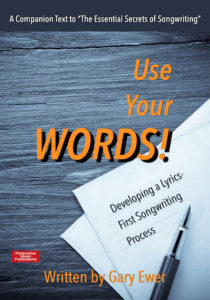Everyone has a songwriting style, and if you listen to enough of someone’s music you’ll start to hear those similarities, assuming it’s not immediately obvious.
Similarity between songs is not a horrible wrong that must be corrected. It’s unavoidable. And it’s a part of being creative in the sense that creativity usually builds on things we know.
 The Essential Secrets of Songwriting 10-eBook Bundle comes with a free 11th eBook: “Use Your Words! Developing a Lyrics-First Songwriting Process.” Start putting your lyrics front & centre!
The Essential Secrets of Songwriting 10-eBook Bundle comes with a free 11th eBook: “Use Your Words! Developing a Lyrics-First Songwriting Process.” Start putting your lyrics front & centre!
But when excessive similarities exist such that every time someone hears a song of yours they feel that they’ve heard it before… well, that’s obviously a problem that needs to be addressed.
If you find that all of your latest songs are showing an annoying sameness, here are some ways to address it:
- Experiment with new time signatures. Most songs are in 4/4 or some other related time signature (2/4, 4/2. etc). Those time signatures arrange your music in an alternating strong beat-weak beat feel. So try 3/4 time, which usually gives us a strong beat followed by 2 weak beats (as in “The Times They Are A-Changin'”). There are others that can be fun to practice: 5/8 or 5/4, and 7/4, which will sound like alternating 4/4 and 3/4 bars.
- Avoid the same formal design. If all your songs are in the verse-chorus-bridge format, you’re going to get that “Wow, this sounds like my last song” feeling by the time you reach the bridge. The formal design of a song is a strong contributor to why one song sounds similar to another. Since songs are just a collection of ideas, it should be possible to rearrange that song to sound fresher and more innovative. Try starting with the chorus, or using an instrumental solo break instead of a bridge. There are lots of alternatives to changing things up.
- Don’t constantly favour major or minor keys. If you find yourself always choosing a minor key for your songs, you’re likely finding that your chord choices themselves are showing a lack of creativity. So be sure to choose a good mix of major and minor keys. And don’t forget that it’s a great option to start a song in minor and switch to major for the chorus. (But not in every song, of course!)
- Changing tempo: the forgotten element. Many songwriters unfortunately have a 2-speed option they always select: If the song is fast, it’s usually 120-132 bpm; if it’s slow, it’s around 80 bpm or so. The mood of a song can change dramatically if you nudge it in one direction or another. So take that fast song that you’ve been playing at 132 bpm, and see what emerges when you slow it to something like 116 bpm. Or even a move from 80 to 96 can allow a different mood to come forward. And changing the tempo you thought you’d use can allow new melodic or lyrical ideas to happen. I’ve always found changing the tempo to be one of the most important modifications a songwriter can do to their song.
- Keep your lyric ideas fresh and new. Love songs still work. But if you’re always singing about being tossed aside by your lover, your listeners will feel they’ve heard your new song before, even before they get to the first chorus. It may be time to spend a day or two simply writing down ideas for songs. It’s also a very useful exercise to take four or five albums from a favourite performer, and write down the basic topics they’ve sung about, just to see how diverse their ideas are. Sure, half of them might have been love songs, but when you dig down into the lyric, you discover that there’s a different side, something that sets the song apart from all their other ones. To avoid sameness, you need to be giving your fans new topics, new opinions, and that means new lyrical experiences.
 Written by Gary Ewer. Follow Gary on Twitter.
Written by Gary Ewer. Follow Gary on Twitter.
 “The Essential Secrets of Songwriting” eBook bundle includes“Writing a Song From a Chord Progression”. Discover the secrets of making the chords-first songwriting process work for you.
“The Essential Secrets of Songwriting” eBook bundle includes“Writing a Song From a Chord Progression”. Discover the secrets of making the chords-first songwriting process work for you.











6. Incorporate chromatic chords in your progressions.
7. Use modulation in chord progressions
8. Try a modal scale you haven’t used before
9. Change time signature from verse to chorus, bridge, etc.
10. Change your instrument tuning. If playing guitar, try drop and open tunings. See Joni Mitchell for example.